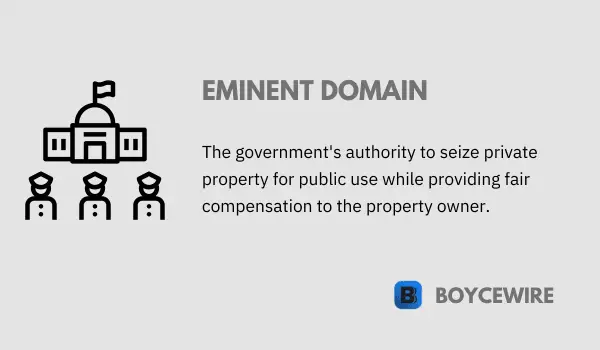Eminent Domain: Definition, How it works & Examples

What is Eminent Domain?
Eminent domain is a legal principle that allows governments to acquire private property for public use. Also known as ‘compulsory purchase’ or ‘expropriation’ in various jurisdictions, it remains one of the most powerful tools available to the state, yet also one of the most contentious. Tracing its roots back to the Roman Empire, the concept has evolved over centuries, being shaped by different legal, social, and political contexts. The power of eminent domain underscores the tension between two fundamental rights: the individual’s right to property and the state’s obligation to serve the public good. This article delves into the legal framework, process, and controversies surrounding eminent domain, aiming to provide a comprehensive understanding of this complex and fascinating subject.
Key Points
- Eminent domain is the legal authority of a government to take private property for public use.
- It allows governments to acquire land or property for projects that serve a public purpose, such as infrastructure development, public utilities, or urban redevelopment.
- The process typically involves notifying the property owner, assessing the value of the property, and offering just compensation.
The Legal Framework for Eminent Domain
Eminent domain is rooted in constitutional law, primarily in the Fifth Amendment of the United States Constitution, which states, “…nor shall private property be taken for public use, without just compensation.” This is known as the “Takings Clause” and provides the fundamental legal basis for eminent domain in the United States.
The legal authority for eminent domain isn’t confined to the federal level; it’s also embedded in state constitutions and statutes. The details and processes may vary from state to state, but all must adhere to the Fifth Amendment’s principles of public use and just compensation.
Over the years, U.S. Supreme Court cases have shaped the interpretation and application of eminent domain. Two pivotal cases are Berman v. Parker (1954) and Kelo v. City of New London (2005). In the Berman case, the Court broadened the definition of “public use” to include “public purpose,” such as eliminating blighted properties. The Kelo case further extended this definition, allowing private property to be taken and given to another private entity for economic development, sparking widespread controversy and reform efforts.
In other countries, the concept of eminent domain (though not always known by that name) is typically regulated by constitutional or statutory provisions. For instance, in the United Kingdom, it’s often referred to as “compulsory purchase,” while in Canada, it’s called “expropriation.” The precise mechanisms, scope, and protections related to eminent domain can vary significantly from one country to another, reflecting diverse legal traditions and societal norms.
In essence, the legal framework for eminent domain aims to strike a balance. On one hand, it grants governments the authority they often need to pursue projects that benefit the public. On the other, it provides protections for property owners, most importantly, the requirement for just compensation and the principle of due process.
Eminent Domain Process
The process of eminent domain can be quite complex and can vary depending on the jurisdiction, but there are several common steps typically involved:
Once a public entity decides that a particular property is necessary for a public project, it will typically make an initial offer to the property owner. This offer is usually based on an appraisal of the property’s fair market value. If the owner agrees to the offer, the property is purchased just like any other real estate transaction.
2. Appraisal and Determination of Just Compensation
If the property owner does not agree to the initial offer, the public entity will typically conduct a more formal appraisal to determine “just compensation”. This is the amount required by the Fifth Amendment to the U.S. Constitution, and it’s generally defined as the fair market value of the property. This involves determining what a willing buyer would pay a willing seller for the property in question.
3. Condemnation Proceedings
If negotiations fail and the property owner is unwilling to sell at the offered price, the public entity can start condemnation proceedings. This is a lawsuit where the entity seeks to exercise its power of eminent domain. In these proceedings, the government must demonstrate two things: first, that the taking of the property is for a public use or benefit, and second, that the owner is being offered just compensation for their property.
4. Appeal Process
Following the condemnation proceedings, the property owner has the right to appeal the decision. This process varies by jurisdiction, but generally, an appeal must be based on a claim that the condemnation was not for a public use or that the compensation was not just. If the appeal is successful, the public entity may be ordered to pay a higher amount or, in some cases, may not be allowed to take the property at all.
1. Initial Offer and Negotiation
Conclusion
It’s worth noting that, throughout this process, property owners often engage legal representation to ensure their rights are protected. While the eminent domain process can seem daunting, it’s designed to balance the needs of the public with the rights of the individual property owner. However, the fairness and efficacy of this process remain subjects of ongoing debate.
The Principle of Just Compensation
Explanation of “Just Compensation”
Just compensation is generally defined as the fair market value of the property — what a willing buyer would pay a willing seller in an open market, under no pressure to buy or sell. It’s designed to put the property owner in the same financial position they would have been in had the taking not occurred.
Methods for Determining Compensation
There are several approaches used to determine just compensation. The “comparable sales” method is often used for residential properties, where the value of similar properties recently sold in the area is considered. For commercial properties, the “income capitalization” approach might be used, where the property’s value is based on the income it produces. The “cost” method, based on the cost of replacing the property, can be applied if the property has unique features making it difficult to find comparable sales or income data.
The compensation should also cover any incidental losses, such as the cost of moving or business interruption for commercial properties.
Challenges and Disputes in Calculating Just Compensation
While the principle of just compensation seems straightforward, in practice, it often leads to disputes. One of the main reasons is that property owners and public entities may have vastly different views on what constitutes “fair market value.” Additionally, the issue of “highest and best use” can create disputes. This principle implies that the value of the property should be based not only on its current use but also on the most profitable, legally permissible, and physically possible use.
Property owners may also argue for compensation for intangible, subjective losses that aren’t easily quantifiable, such as emotional attachment to a family home or the inconvenience of having to move.
In cases where agreement cannot be reached, the value might be determined by a jury or a court, or in some jurisdictions, an independent tribunal.
Conclusion
While the principle of just compensation is designed to protect property owners, it’s clear that the determination of “just” is not always simple or straightforward. This complexity is a significant part of the eminent domain debate.
Examples of Eminent Domain
Eminent domain has been exercised in numerous cases throughout history, often with the intention of fulfilling public objectives. However, many of these instances have sparked controversy. Here are a few examples:
1. The Kelo Case (Kelo v. City of New London, 2005)
In the Kelo Case, the city of New London, Connecticut, used eminent domain to seize private homes for a private development project. The city argued that the project would create jobs and increase tax revenues, thus serving a public purpose. The U.S. Supreme Court upheld the city’s actions, sparking widespread debate and leading many states to reform their eminent domain laws.
2. The Creation of the Interstate Highway System
In the mid-20th century, the construction of the Interstate Highway System resulted in the widespread use of eminent domain. While this project led to significant improvements in transportation and had wide-reaching economic benefits, it also displaced many individuals and businesses and disrupted local communities.
3. The Poletown Case (Poletown Neighborhood Council v. Detroit, 1981)
In the Poletown Case, the City of Detroit used eminent domain to acquire an entire neighborhood to allow for the expansion of a General Motors plant. The Michigan Supreme Court initially supported the city’s actions, but the decision was later overturned in a different case in 2004 (County of Wayne v. Hathcock), marking a shift in the court’s stance on public use.
4. HS2 Rail Project, United Kingdom
The High Speed 2 (HS2) rail project in the UK involves the compulsory purchase (the UK’s equivalent of eminent domain) of numerous properties to make way for new rail lines. While the project promises significant benefits in terms of transportation and economic growth, it has also faced opposition from property owners and environmental activists.
FAQs
Eminent domain is the legal authority of a government to take private property for public use, provided that just compensation is paid to the property owner.
Eminent domain is necessary to allow governments to acquire land or property for projects that serve a public purpose, such as infrastructure development, public utilities, or urban redevelopment.
The process typically involves a government entity initiating condemnation proceedings, which include notifying the property owner, assessing the value of the property, and offering just compensation. If the owner disagrees with the compensation offered, they have the right to challenge it in court.
Traditionally, public use referred to projects directly benefiting the public, such as roads, schools, or parks. However, the definition has expanded to include economic development, blight removal, and other projects with potential public benefits.
About Paul
Paul Boyce is an economics editor with over 10 years experience in the industry. Currently working as a consultant within the financial services sector, Paul is the CEO and chief editor of BoyceWire. He has written publications for FEE, the Mises Institute, and many others.

Further Reading
 Disintermediation - Table of Contents What is Disintermediation? Understanding Disintermediation Causes Effects Advantages and Disadvantages Examples FAQs Disintermediation: Definition, Causes, Effects &…
Disintermediation - Table of Contents What is Disintermediation? Understanding Disintermediation Causes Effects Advantages and Disadvantages Examples FAQs Disintermediation: Definition, Causes, Effects &…  Monopolistic Competition: Characteristics & Examples - A market that has Monopolistic structure can be seen as a mixture between a monopoly and perfect competition. Whilst monopoly…
Monopolistic Competition: Characteristics & Examples - A market that has Monopolistic structure can be seen as a mixture between a monopoly and perfect competition. Whilst monopoly…  Earnings Per Share - Earnings per share (EPS) is a financial ratio that represents the portion of a company's profit allocated to each outstanding…
Earnings Per Share - Earnings per share (EPS) is a financial ratio that represents the portion of a company's profit allocated to each outstanding… 
